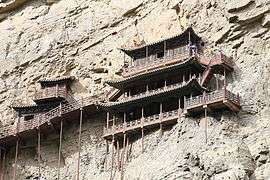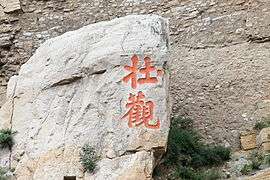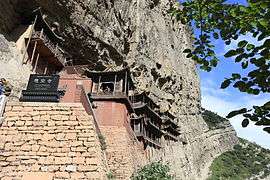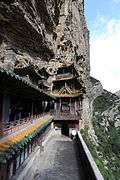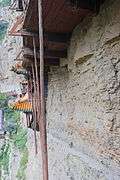Hanging Temple
Coordinates: 39°39′57″N 113°42′18″E / 39.66583°N 113.70500°E / 39.66583; 113.70500

The Hanging Temple
The Hanging Temple, also Hanging Monastery or Xuankong Temple (simplified Chinese: 悬空寺; traditional Chinese: 懸空寺; pinyin: Xuánkōng Sì) is a temple built into a cliff (75 m or 246 ft above the ground) near Mount Heng in Hunyuan County, Datong City, Shanxi province, China. The closest city is Datong, 64.23 kilometers to the northwest. Along with the Yungang Grottoes, the Hanging Temple is one of the main tourist attractions and historical sites in the Datong area. Built more than 1,500 years ago, this temple is notable not only for its location on a sheer precipice but also because it is the only existing temple with the combination of three Chinese traditional religions: Buddhism, Taoism, and Confucianism. The structure is kept in place with oak crossbeams fitted into holes chiseled into the cliffs. The main supportive structure is hidden inside the bedrock.[1] The monastery is located in the small canyon basin, and the body of the building hangs from the middle of the cliff under the prominent summit, protecting the temple from rain erosion and sunlight. Coupled with the repair of the dynasties, the color tattoo in the temple is relatively well preserved. On December 2010, it was listed in the “Time” magazine as the world's top ten most odd dangerous buildings.
History
According to legend, construction of the temple was started at the end of the Northern Wei dynasty by only one man, a monk named Liao Ran (了然). Over the next 1,400 years, many repairs and extensions have led to its present-day scale.[2]
Photo gallery
References
External links
Buddhist temples in China |
|---|
|
| |
|---|
| Architectonic elements | |
|---|
| Men (gates) | |
|---|
| Buildings | |
|---|
|
|
|
|
| Notable Buddhist temples in China |
|---|
| |
|


